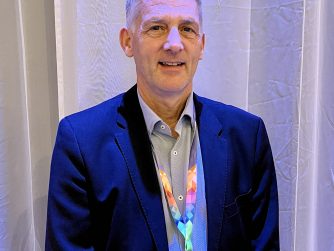An interview with Sophie Bosma MD PhD, from The Netherlands Cancer Institute, Amsterdam recorded at the 14th European Breast Cancer Conference in Milan.
MILAN, Italy—The optimal radiation boost dose to protect young patients with early breast cancer has been investigated with ten years of follow up in the “Young Boost trial” conducted in the Netherlands. The study randomized between giving patients a low radiation dose as a boost to their standard radiotherapy or a high dose.
At the 14th European Breast Cancer Conference held in Milan Radiation Oncologist Sophie Bosma MD PhD, from The Netherlands Cancer Institute in Amsterdam reported that a low dose had comparable efficacy with lower toxicity and should now be recommended. In Milan she talked about the findings with Audio Journal of Oncology reporter Peter Goodwin.
AUDIO JOURNAL OF ONCOLOG, with: Sophie Bosma MD PhD, Netherlands Cancer Institute
IN (Goodwin): “For your young patients ….. OUT: …..for the Audio Journal of Oncology I’m Peter Goodwin 8:46secs
SEE:
MORE:
News release:
Low-dose radiotherapy boost helps prevent local recurrence with better cosmetic outcomes in young breast cancer patients
The researchers conclude that the ‘benefit does not justify the increased impact on cosmetic outcomes’.
Bosma said: “In both groups local recurrence rates were very low and much better than expected. Although we did find a difference between the two groups in terms of the recurrence rate, this was a small difference which must be weighed against the increase in side effects, such as fibrosis.
“Knowing the long-term impact of a treatment on cancer control as well as on unwanted side-effects is crucial in helping individual patients get the best possible treatment.”
Michail Ignatiadis MD PhD from the Institut Jules Bordet in Brussels, Belgium, Chair of the 14th European Breast Cancer Conference, who was not involved in the research, said: “Radiotherapy plays an important role in breast cancer treatment, especially in young women where there is a higher risk of the breast cancer returning. This important study provides critical information for the optimal boost radiotherapy dose for achieving local control without compromising the cosmetic outcome.”
Abstract no: 4LBA,
“Young boost randomized phase III trial of high vs low boost radiation in young breast cancer patients: 10-year results”,
https://cm.eortc.org/cmPortal/Searchable/ebcc14/config/Normal#!sessiondetails/0000107220_0
4LBA LBA Mini Oral – Young boost randomized phase III trial of high vs low boost radiation in young breast cancer patients: 10-year results
European Journal of Cancer:
https://www.ejcancer.com/article/S0959-8049(24)00180-1/fulltext
Sophie Bosma et al:
1The Netherlands Cancer Institute, Radiation oncology, Amsterdam – HollandPTC- Delft, The Netherlands;
2Erasmus MC Cancer Institute, Statistics, Rotterdam, The Netherlands;
3The Netherlands Cancer Institute, Radiation oncology, Amsterdam, The Netherlands;
4Institute Curie, Radiation oncology, Paris, France;
5Catharina Hospital, Radiation oncology, Eindhoven, The Netherlands;
6University Medical Center Groningen, Radiation oncology, Groningen, The Netherlands;
7The Netherlands Cancer Institute, Surgical Oncology, Amsterdam, The Netherlands;
8Institute Verbeeten, Radiation oncology, Tilburg, The Netherlands;
9Radboud University Medical Center, Radiation Oncology, Nijmegen, The Netherlands;
10Radiotherapiegroep, Radiation oncology, Arnhem, The Netherlands;
11Amsterdam UMC, Pathology, Amsterdam, The Netherlands;
12Iridium Netwerk, Antwerp, Belgium, University of Antwerp, Faculty of Medicine and Health Sciences, Radiation oncology, Antwerp, Belgium;
13MAASTRO-GROW School for Oncology and Developmental Biology- Maastricht University Medical Centre, Radiation oncology, Maastricht, The Netherlands
Background: An extra radiation boost dose to the primary tumour bed in addition to whole-breast irradiation (WBI) reduces local recurrence (LR) risk after lumpectomy. As young age is a risk factor for LR, the young boost trial (NCT00212121) investigated whether an increased boost dose could improve local control in young patients. Here, we present the results of the 10-year primary analysis.
Material and Methods: Between 2004 and 2011, patients≤50 yrs with pT1-2, pN0-2a invasive breast cancer after a microscopically complete excision (focally involved margins were allowed) were randomly assigned to receive a boost of 26 Gy (high) or 16 Gy (low) to the tumour bed. Patients were stratified by age, tumour size, lymph node involvement, interstitial/ external boost, and institution. Primary endpoint was local control at 10 years. The revised design (2008) assumed a 3.5% difference in local control at 10 years (from 92 to 95%; power 90%; two-sided significance level α of 5%). All new tumours in the ipsilateral breast were counted as LR. We used competing risk analysis with death as competing risk.
Results: In total, 2421 patients were randomized in 32 centres in the Netherlands, France, and Germany. 1211 patients were assigned to a high and 1210 patients to a low boost. Median follow-up was 11.7 years. Baseline characteristics were well-balanced between both two arms. Median age at diagnosis was 45 years (IQR 41-48), the median pathological diameter was 15 mm (IQR 1-80), and 70% was pN0. Tumours were grade 2 or 3 in.82 % and subtype was 67% ER+HER2-, 20% TNBC, and 13% HER2pos. 65% was treated with a sequential boost; 35% with a simultaneously integrated boost. Boost techniques consisted of X-ray beams in 75%, electrons in 20%, 1% interstitial boost and 4% others. Systemic treatment was given to 82% of patients. In total, 109 local recurrences have occurred (61 low boost, 48 high boost). LR was the first event for 42 patients in the low boost and 23 patients in the high boost arm. The 10-year LR-rate for patients treated with a low boost was 4,4% (95% CI 3,4-5,8) versus 2,8% (95% CI 1,9-3,9) in patients treated with a high boost, HR 0.61 (95% 0.39-0.96), p 0.032. Factors significantly associated with LR in multivariable analysis were boost dose, final margin status, subtype, and the use of chemotherapy. The cumulative incidence of marked or moderate fibrosis in the boost area was 27% patients treated with a low boost vs 48% patients treated with a high boost.
Conclusions: Local control in young breast cancer patients was excellent. The primary endpoint that a high radiation boost after whole-breast irradiation improves local control by at least 3.5% was not met. The small statistically significant benefit does not justify the increased impact on cosmetic outcomes.








